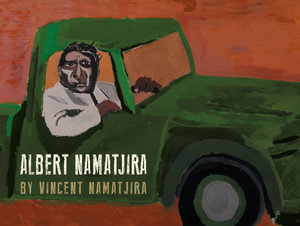Albert Namatjira by Vincent Namatjira

A signature style for some Aboriginal artists, dark swathes of colour entice the reader to pick up this biography of Vincent’s great grandfather, Albert Namatjira. Albert, an Aranda man and artist, painted stunning water colour landscapes featuring Country west of Alice Springs and these are reprised by Vincent on the end papers and dotted throughout the book. This arresting look at Albert’s life shows his birthplace, his early life and work, while his collaboration with Rex Battarbee saw him develop his watercolour paintings of Central Australia. His first exhibitions in Melbourne and Sydney sold out, and he travelled widely as accolades mounted up. His portrait was painted by celebrated portraitist William Dargie and won the 1956 Archibald Prize. Travelling, Albert always missed his home, the colours of Country, the simpler life with his family.
The story takes a turn as Vincent outlines the limits on Albert’s life and career. Because Albert was representing Australia he was made an Australian citizen, the first Aboriginal person to receive citizenship. While working on his car in Alice Springs, Albert’s hand was damaged and this caused immense changes to his life. As a citizen he was allowed to buy alcohol, and sharing this with relatives brought him in contact with the law and he was jailed. The man who had represented Australia, met the Queen and produced paintings known world wide, was imprisoned. Released, his health deteriorated and he died in hospital at Alice Springs in 1959, aged 57.
He left behind a legacy which is unequalled. He changed the platform of art in Australia, showing Indigenous art to the world, taking its place within the pantheon of Australian art. His life reflects the changing relationship between Aboriginal people and the new arrivals, while the art work produced both by Albert and his great grandson, Vincent, stands out as milestones in the work which proclaims Australia. Readers new to the story of Albert Namatjira will be gutted at the indignities heaped upon this man, appalled that an artist was treated in such a way and mollified that steps have been taken to bring his story to a wider audience. Vincent’s use of humour is a standout contribution to the debate, and younger readers will laugh at the images of the queen and people in positions of power.
Vincent focusses on colour, using intense blazes to accentuate the image he is revealing. Vincent began with dot painting, but moved to this style as it lent more humour and poignancy to his work. A collection of his images of Albert Namatjira have been bought by the Queensland Art Gallery/Gallery of Modern Art, while his portrait of Albert won the Archibald Prize in 2021.
This book is a loving and timely tribute to a great man, one who promoted the recognition of Aboriginal people in Australia through his work and industry. His exhibitions were a success, bringing the love of Country to the city, ensuring a wider audience became aware of the bush.
He was awarded the Coronation Medal by Queen Elizabeth, a rather ironic presentation as it was another 23 years before he was officially an Australian citizen. Teacher's notes are available.
Themes: Prejudice, Albert Namatjira, Aboriginal art, Aboriginal people, Racism, Archibald Prize, Central Australia, Alice Springs.
Fran Knight